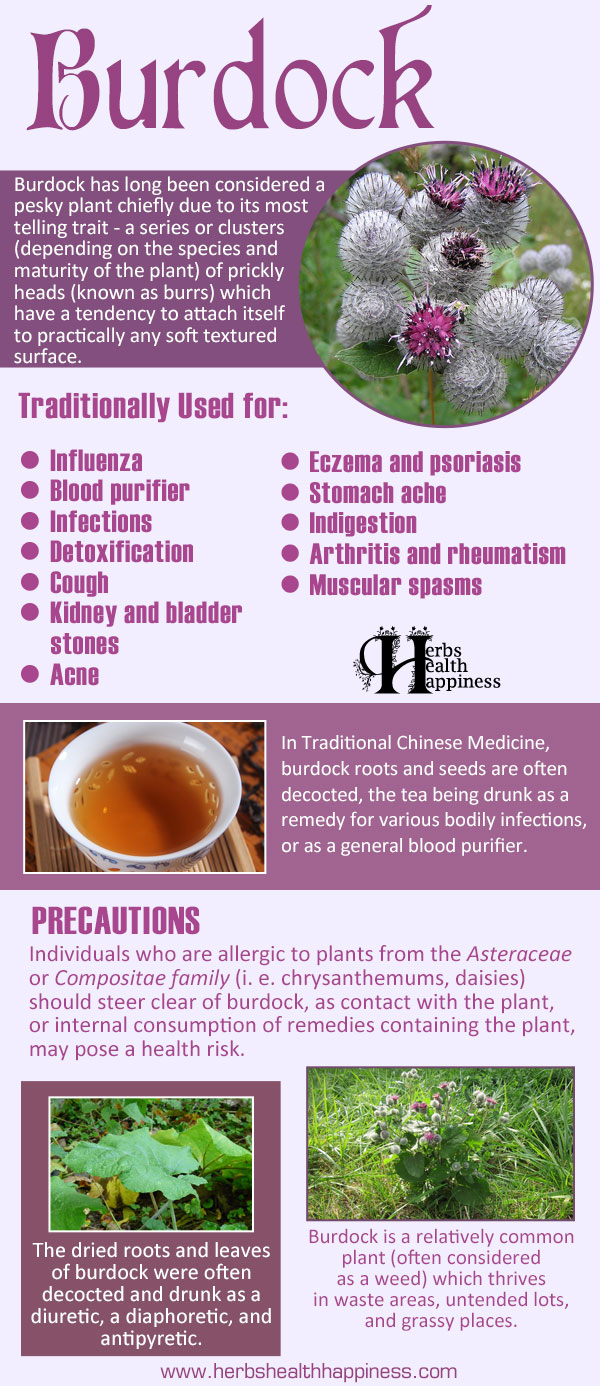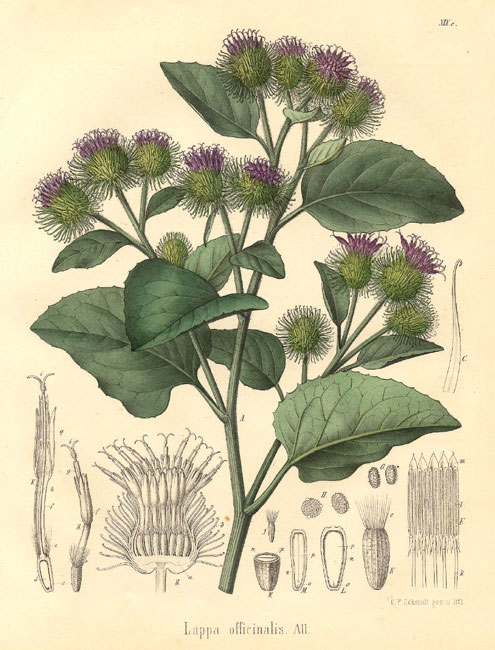Burdock

Uses Of Burdock - image to repin / share
Graphic - herbshealthhappiness.com. Image sources - see foot of article.

Burdock - Botany And History
Burdock is a relatively common plant (often considered as a weed) which thrives in waste areas, untended lots, and grassy places. Known the world over for its relative hardiness and for the unique prickly heads which have a tendency to catch on to pet fur or human clothing, burdocks were initially an Old World plant which thrived in nearly any condition.
Characterised by its dark-green, often heartshaped leaves which have a tendency to grow disparately, some ranging between a few inches wide to others being almost as wide as the span of a human's hand, burdock has long been considered a pesky plant chiefly due to its most telling trait - a series or clusters (depending on the species and maturity of the plant) of prickly heads (known as burrs) which have a tendency to attach itself to practically any soft textured surface. Burdocks are also notable for their hollow leafstalks and for their fuchsia or lavender hued efflorescence replete with tiny vine-like growths which springs from its burr. Some species of burdock are also notable for their uniquely-shaped or otherwise sizeable burr, the range of which may vary from no more than five millimeters to about the size of a marble. [1]
Because of the fact that burdock possesses burrs that stick to fur and clothing, they are often mistaken for cockleburs (genus Xanthium), which also possesses hairy or spiked burrs that stick to clothing, with the only difference being their size, as cockleburs burrs tend to be far smaller than burdock burrs. Burdock may also be confused for rhubarb chiefly due to its leaves, although such instances are rare and only occur through inexpert identification.

Burdock - Herbal Uses
While burdock may seem generally useless to the modern individual aside from its possible employment for pranks (as it is wont to be used by children or childish individuals who go out hiking or camping), burdock actually played an important role in the early dietary habits of many human civilizations. Forager peoples and hunter-gatherers may have perhaps dug out burdock roots and consumed them as a type of root-crop, as the young taproot of the plant is crisp, sweet, and possessed of a mildly pungent aroma. [2] Today, the practice of cultivating or wild-crafting burdock roots for the purpose of human consumption persists in nations such as China, Japan, and Korea, where it is often served in accompaniment with other vegetable-based or fish-based dishes, or otherwise consumed as an appetizer or a snack in its own right. Burdock roots, regardless of age, have a tendency to veer towards tasting a little off, with its flavour having been compared to muddy radishes. This muddiness is typically remedied by soaking sliced, shredded, julienned, or grated roots in water prior to preparation or consumption. The flavour of the roots may also be changed or enhanced by allowing it to soak in a saline solution prior to consumption, or by creating a sauce that accompanies it upon serving.
When cooked as a root vegetable, burdock root works well with dishes such as pork, although it may also be mixed with beef or seafood, albeit with lesser flavourful impact. In the olden times, burdock root was mixed with dog meat (a then non-taboo and commonplace foodstuff in China and some parts of Japan), and was a common addition to hotpots (shabu-shabu / nabemono / shuan yang rou). Burdock root may be integrated into meat or vegetable-based soups and stews, or may otherwise be julienned and stir-fried with an assortment of vegetables, usually accompanied by a generous integration of diced or ground pork-meat. The roots may even be pickled and eaten as a side dish, or otherwise incorporated as an ingredient for seafood-based dishes. Pickled burdock root, often accompanied by pickled ginger root, is a common palate cleanser, appetizer, and condiment in Japanese cuisine. It is among one of the more uncanny foodstuffs in traditional Japanese cuisine, and is popular chiefly due to its having been advocated largely by experts and supporters of the macrobiotic diet. [3]
The leaves of the plant are also quite edible, having been employed as a vegetable green in China and Japan since ancient times. Nowadays, cultivars expressly bred for the use of its leaves as a vegetable have become quite commonplace in Japan, where even the immature flower stalks (harvested prior to flowering) are consumed alongside the leaves as a type of vegetable.
Outside of Asian cultures, the most significant contribution of the plant to Western history was its early employment as a bittering agent for the creation of beer and ales long before the eventual introduction of hops and the subsequent change in heralded to beer making. [4] As with some Asiatic cultures, the Westerners of the Mediaeval periods may have also consumed burdock root as a type of root crop - a practice which was later echoed by frontier-folk in the early days of the American Colonies. Prior to the arrival of the settlers however, the practice of consuming burdock root for food was already very commonplace among the First Peoples of the Americas. It may have even been possible that the First Peoples themselves introduced some settlers who were ignorant to the burdock's edibility to the practice of its consumption.

One of the oldest and perhaps most iconic products derived from burdock are drinks which are comprised of the combination of burdock and dandelion. Initially concocted by Europeans (typically attributed to the Irish), the dandelion and burdock beverage combination has spawned a range of drinks that include beer, wine, flavoured mead, ale, and even soft drinks. Initially brewed by combining dandelion flowers and cleaned, peeled and sliced burdock roots which were then allowed to ferment, nowadays only very few authentically made or brewed dandelion and burdock beverages are left, although synthetic versions still prove to be somewhat popular, with its most common consuming demographic found throughout the British Isles. Burdock and dandelion beverages were initially marketed as health drinks (it was believed to be a general tonic), and was, for a time flavoured with the help of wintergreen, mint, or sassafras - a practice which was later banned sometime in the early 1960s due to sassafras's active compound safrole having been found to be a mild carcinogenic. [6] Burdock and dandelion wine still prove to be quite popular in smaller towns or village settings, where home-brewers still create them in small batches either for personal or general consumption in limited numbers, although some microbrewries and specialty wine or spirits shops do sell authentic 'period' burdock and dandelion beverages. [7]
Burdock has also been employed in folk medicine since time immemorial, with is most prolific usage dating back to the Early Middle Ages. The dried roots and leaves of burdock were often decocted and drunk as a diuretic, a diaphoretic, and antipyretic. It was typically given to individuals suffering from influenza or some other type of viral malaise, as its cleansing action (as facilitated by urination and sweating) not only helped to hasten recovery, but it's purported blood purifying properties also helped to combat whatever ailment was being treated more efficiently. [8] In Traditional Chinese Medicine, burdock roots and seeds are often decocted, the tea being drunk as a remedy for various bodily infections, or as a general blood purifier. It is also not uncommon to drink burdock tea while on a cleansing or restorative fast, or to partake of it in minute doses while on a weight-loss regimen (the latter, however, is ill-advised). Traditional Chinese Medicine also considers alcoholic beverages brewed from burdock to be therapeutic in far more ways than is common in the Western sphere of herbal medicine. In China, burdock wine is generally drunk as a tonic, as a remedy for indigestion, as an appetizer, as an analgesic, an aphrodisiac, an anti-coagulant (and subsequently, a heart tonic) and as a detoxifying beverage. The seeds of the plant when decocted were also employed as a remedy for incontinence and, in earlier times was even believed to help rid the kidneys and bladder of stones. Burdock has even been employed (in both Eastern and Western herbal medicine) as a remedy for coughs, and as a general nutritive drink for individuals with impaired immune systems - a practice which is common in Japan and China, where nourishing stocks or stews containing burdock root and young shoots are given to convalescent individuals and nursing mothers, the latter practice (also employed in the West) stemming from its galactagogue properties. [9]
Likewise, alcoholic extracts derived from burdock's constituent parts are also employed for the exact same purposes, although in smaller dosages, as these tinctures (derived from macerating dried plant parts in alcohol) tend to be more concentrated than wines or tisanes. Tinctures of the plant may even be mixed with a base oil to create liniments that are used as antifungal and analgesic agents. [10]
Very potent decoctions of burdock root have also been applied topically as a remedy for ichthyosis (a rare, often debilitating, and disfiguring skin condition), eczema, psoriasis, and acne. Milder decoctions of the root and leaves (or sometimes only the dried leaves) can be drunk as a remedy for griping and as a tonic beverage for toning the digestive system, and for easing stomachaches and indigestion. An alternative would be to soak dried roots and leaves in a base oil and allow it to macerate for several months, shaking every week or so. The subsequent macerated oil may then be distilled and employed as a beautifying agent, hair oil, and even as an ointment for the relief of rheumatism and arthritis. [11]
A poultice of dried leaves mixed with a little base oil may even be heated and applied to aching body parts or rheumy joints in order to alleviate the discomfort. In traditional folkloric medicine, such poultices were even applied to sore and tired feet after a long day's hike. It was believed to treat gout effectively, and to prevent muscular spasms associated with over-exertion. Poultices made from burdock leaves may even help to soothe the pain and discomfort associated with skin lesions, topical ulcerations, and allergic breakouts. [12]

Burdock - Contraindications And Safety
While burdock is deemed generally safe when consumed as a foodstuff, care should be taken when employing burdock topically or when harvesting burdock, as the tiny hairs found on its leaves and stems can cause allergic reactions in individuals who have very sensitive skin. Individuals who are allergic to plants from the Asteraceae or Compositae family (i. e. chrysanthemums, daisies) should steer clear of burdock, as contact with the plant, or internal consumption of remedies containing the plant may pose a health risk.
Due to its anti-coagulative properties, individuals who are under similar synthetic medications should limit or altogether discontinue their intake of any products containing burdock, as it may interfere with the body's ability to facilitate blood clotting. Persons who are set to undertake any type of surgery should cease the consumption of burdock or medicines containing the plant at least two weeks prior to the appointment lest complications occur. Likewise, pregnant women should steer clear of burdock tea and limit their consumption of burdock root during pregnancy as it may stimulate the uterus and cause miscarriages (a very rare but nevertheless possible occurrence). Furthermore, individuals who partake of water pills should likewise limit their intake of the herb, lest its diuretic action interact with the medications, resulting in dehydration as well as nutrient and electrolyte depletion.
Burdock - Esoteric Uses
When employed for magickal purposes, burdock is commonly associated with protection, healing, and health. In most branches or systems of magick, it is employed in much the same way as it would be medicinally, although Voodoo, Hoodoo, and some branches of folk magick and shamanism typically employ burdock as an amulet, especially its root, although its leaves and burrs may also be employed. In sympathetic magick, the burrs of burdock may be employed as protective articles for warding off evil, as they can be used in herb-based hex bottles, or they can be used to attract luck or fortune (if such is the spellworker's intention), due to its tendency to 'cling' to whatever comes into contact with it. In Voodoo, Hoodoo, and some branches of shamanism, the taproot of burdock that has experienced its first year of growth and subsequent 'hibernation' may be dug out, carved, and worn as an amulet (usually by encasing it in a juju bag, mojo bag, or Medicine pouch) and worn upon one's person to counter hexes and drive off misfortune. [13] Practitioners of hoodoo even create ointments which contain burdock root and prescribe it to restore flagging sex drive especially in men.
Burdock - Other Names, Past and Present
Chinese: niu bang zi / bang / niu bang
Japanese: gobo
Korean: ueong
Greek: glouteron (attributed)
French: bardane / bardane comestible / herbe aux Teigneux / rhubarb du Diable
Italian / Spanish: bardana / personata
English: beggar's buttons / cocklebur / cockle buttons / fox's clote / great bur / happy major / hardock / harebur
Latin (scientific nomenclature): Arctium lappa / Arctium mnus / Lappa officinalis (other nomenclatures exist, depending upon wild varieties and inter-related species)
Infographic Image Sources:
https://en.wikipedia.org/wiki/File:Villtakjas_2008.jpg
https://pixabay.com/en/tea-da-hong-pao-tea-cup-557436/
https://pixabay.com/en/arctium-tomentosum-downy-burdock-844494/
https://pixabay.com/en/leaf-large-green-autumn-62436/

Burdock (Arctium Lappa)(PD)
References:
[1 - 2] https://en.wikipedia.org/wiki/Arctium
[5] https://www.guardian.co.uk/lifeandstyle/wordofmouth/2011/sep/28/how-make-dandelion-burdock-beer
[6] https://en.wikipedia.org/wiki/Dandelion_and_burdock
[7] https://botanical.com/botanical/mgmh/b/burdoc87.html
[10] https://umm.edu/health/medical/altmed/herb/burdock
[11] https://www.cauldronliving.com/herbs-health-healing/6505-burdocks-herbal-magicalproperties.html
Main article researched and created by Alexander Leonhardt, Scientific Studies report by Dan Ablir.
© herbshealthhappiness.com


1. Famous Chef Sheds 60lbs Researching New Paleo Recipes: Get The Cookbook FREE Here
2. #1 muscle that eliminates joint and back pain, anxiety and looking fat
3. Drink THIS first thing in the morning (3 major benefits)
4. [PROOF] Reverse Diabetes with a "Pancreas Jumpstart"
5. Why Some People LOOK Fat that Aren't
6. Amazing Secret Techniques To Protect Your Home From Thieves, Looters And Thugs
7. The #1 WORST food that CAUSES Faster Aging (beware -- Are you eating this?)
If you enjoyed this page:




























